Home / E / Employee experience (EX)
Employee experience addresses all the interactions between an employee and their employer during their entire time of employment (from recruitment, onboarding, daily work processes, and exiting). Employee experience includes (and affects) engagement, productivity, and retention. Now, more than ever, employee experience is a strategic priority for HR organizations. A positive employee experience can reduce turnover by 25% and improve overall employee performance.
Organizations taking a holistic approach to employee experience create 4 times the revenue and 2 times the profit margins as those who do not, when compared to their competitors. By integrating employee-centric practices into organizational culture and technology, workspace design, and processes, organizations can increase employee satisfaction, create loyalty and enhance employer brand. By evaluating employee experience over key areas, HR can optimize the employee experience to support organizational outcomes for the business, as well as the organization's workforce.
What is Employee Experience?
Employee experience addresses all employee perceptions, emotions, and interactions with an organization for the duration of their employment - including all interactions from recruitment, organizational & HR policies, communications from leaders, daily workspace & work conditions, and exiting the organization.
Having defined and identified employee experience provides the organization with a better understanding of the employee perceptions and interactions that factor into this larger scope of what contributes to employee attitudes. They are more likely to engage in discretionary effort and go beyond job expectations when they feel supported and valued by the organization. Negative touchpoints or moments of frustration (such as conflicts over unclear expectations; not having modern or relevant tools to do their jobs; or encountering roadblocks or obsolete systems) will lead to combination of employee frustration, disengagement, or excessive absenteeism.
Employee experience consists of more than a buffet of options from a range of perks and benefits. Employee experience also includes fewer tangible elements of employee experience (such as the internal level of trust and confidence in the organization, confidence in the integrity of senior leaders, quality of peer relationships, and the ability to make sense of how one’s job fits within the corporate mandate). If an organization tries to address employee experience variables that can be identified and measured while only focusing on compensation, they will miss important opportunities to build a holistic employee experience process with human-centred results.
Great employee experience can be defined in many ways, but one of the best measures is how the value of great employees is attracted to a potential employer. In some talent acquisition markets, research indicates that candidates will rely on internal employee Glassdoor reviews, work-life balance, and opportunities for growth/job opportunity. Employee experience can make organizations preferred employers, reducing time to hire and recruitment costs.
What are the Key Components of Employee Experience?
Workplace
The design and layout of office, remote workspaces, and collaboration areas directly address the perceived physical comfort or productivity of temporary workspaces or collaboration areas. An ergonomic workspace with adequate natural light, and the opportunity to be in a quieter environment improve employee wellness, which improves employee's focus and attention.
Culture and Leadership
An aligned culture has articulated values with open transparency in leadership. Building trust from leaders will support communications and acknowledgement for the contributions made to the completion of work or tasks. It is essential for organization leaders to encourage employees and align them with the vision of the organization; thereby creating engagement.
Technology and Tools
Employees can achieve their potential without unnecessary friction or interruptions from their mode of work process - with smooth modern hardware, smooth software processes, and dependable collaboration tools. Organizations can empower all employees by providing digital means for seamless data capture and collaboration; leading to rapid decision-making.
Policies and Processes
Performance management processes, employee feedback cycles or surveys, and career development these processes all create some kind of structure and fairness. Simple, digital workflows for processes (e.g.: leave requests and expense claims forms) all contribute to reducing burden through organization-induced administrative work assignments, processes, or policies.
How to Measure Employee Experience
Pulse Surveys
Brief and frequent surveys track real time sentiment on key drivers such as workload, managerial support and purpose. If employee response rates to pulse surveys remain above 70 percent this indicates a level of engagement with feedback culture that is very encouraging.
Performance Metrics
Tracking KPIs such as project completion rate, occurrences of errors, and innovations submitted to management provides visibility into the relationship between employee experience initiatives and productivity benefits for your workplace.
Retention Analytics
Analysing metrics like turnover & exit interview themes shows, if experience initiatives are building loyalty. A 10% yearly increase in voluntary retention, for example, is a strong signal of a successful impact.
How to Improve Employee Experience?

Improving the employee experience by keeping these points in check:
1. Strategically Use Measurement Data: Use measurement data to locate sources of friction/pain points.
2. Offer Opportunities: Think about personalized learning and development opportunities, peer recognition and flexible schedules, etc.
3. Early Access to Wellness and Belonging: To foster belonging, expose employees early on to mental health services, an onsite gym, and social events.
4. Foster Open Communication: Create an environment where employees can share their thoughts and feedback openly.
5. Provide Career Development Programs: Offer opportunities for professional growth and skill development to help employees advance their careers.
How Does Employee Experience Impact the Workplace?
An employee experience heavily engaged employees will have much higher engagement scores and will typically achieve 30% higher employee engagement scores than their competitors. Engaged employees will put in 56% more discretionary effort which leads to better customer satisfaction and increased innovation rate. They ultimately take sick leave, reducing absenteeism by as much as 41%.
As employee experience champions work with their leadership, organizational agility improves. Research shows that cross-functional teams tend to deliver projects faster by 23% when clear channels of communication and modern collaboration platforms are facilitated. Positive employee experience impacts the organization's reputation as an employer and further enhances employment referrals.
What Are Good Examples of Employee Experience?

Here are some examples of positive employee experience in the workplace:
Personalized Learning and Development Opportunities
Companies can personalize development opportunities by providing learning and development programs that are created just for them. These programs can show the employee that the company cares about their growth, and specifically their advancement and future as an employee.
Employee Recognition Programs
Recognizing, as well as appreciating, an employee for their work and contributions every year can elevate engagement and loyalty levels. Recognition can also consist of non-monetary recognition, additional vacation time, as well as money, promotion, and leadership roles.
Flexible Work Arrangements
Flexible work arrangements allow employees to choose where, when, and how they work, whether it’s remote work, hybrid schedules, or adjustable hours. This flexibility helps reduce stress, supports personal responsibilities, and promotes a healthier work-life balance. As a result, employees feel more trusted, motivated, and engaged in their roles.
Employee Well-being
Providing support for employee well-being regarding physical, mental, and emotional wellbeing can enhance engagement and productivity level for employees. Wellbeing can be supported through mental health support for employees, wellness activities, and a supportive work environment.
Open Communication & Transparency
Creating a culture of open communication and transparency where employees feel that they can communicate with leaders safely, and where they have all the information and resources, they need to do their job well, will significantly enhance employee engagement.
Can Employee Experience Solutions Help Reduce Turnover?
Employee experience solutions are platforms that bundle pulse surveys, real time surveys, performance indicators, and ways to recognize employees, that can help leaders have insights to act on employee experience. Leaders who spot disengagement early can target in a variety of ways: manager training, improvements in workload, and peer to peer support initiatives. Solving for employee experience solutions can lead to up to 20% lower voluntary attrition rates and allow organizations to retain critical skills.
Difference Between Employee Engagement and Employee Experience
| Aspect | Employee Experience (EX) | Employee Engagement |
|---|

